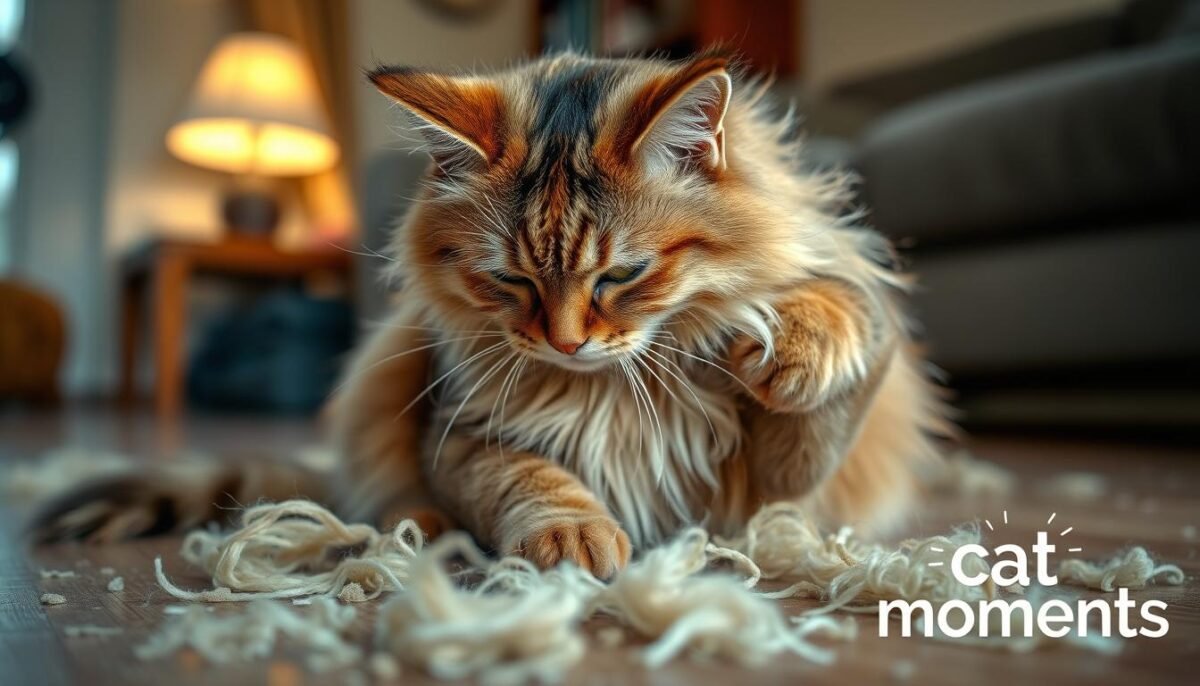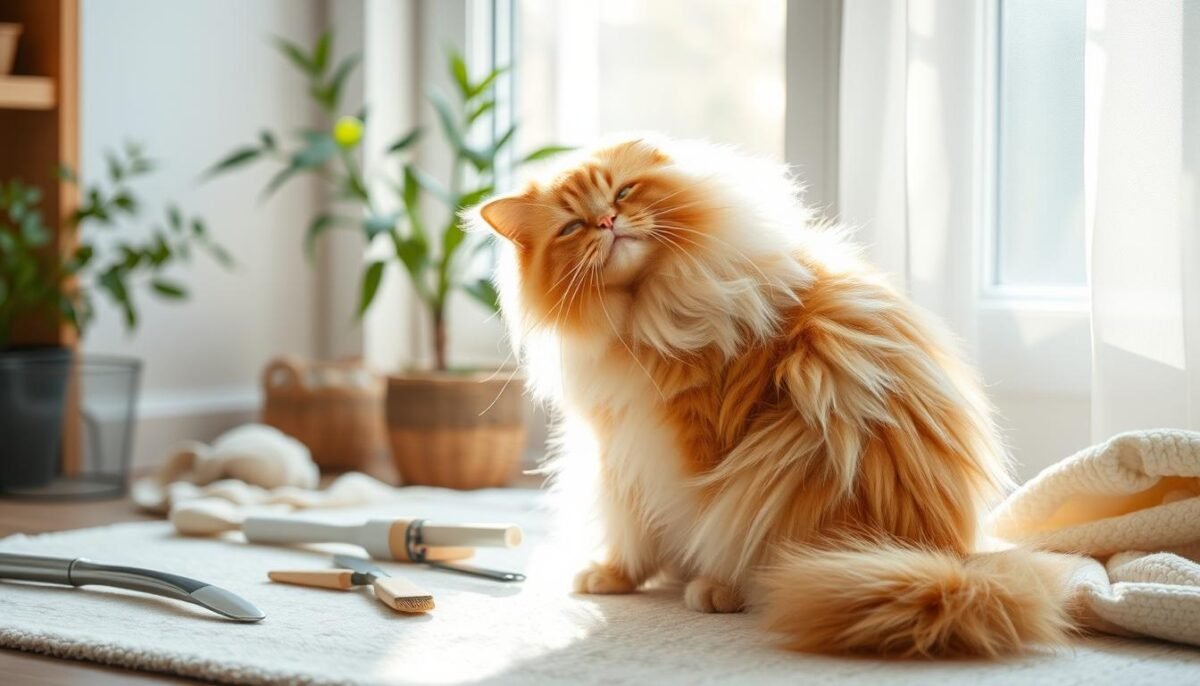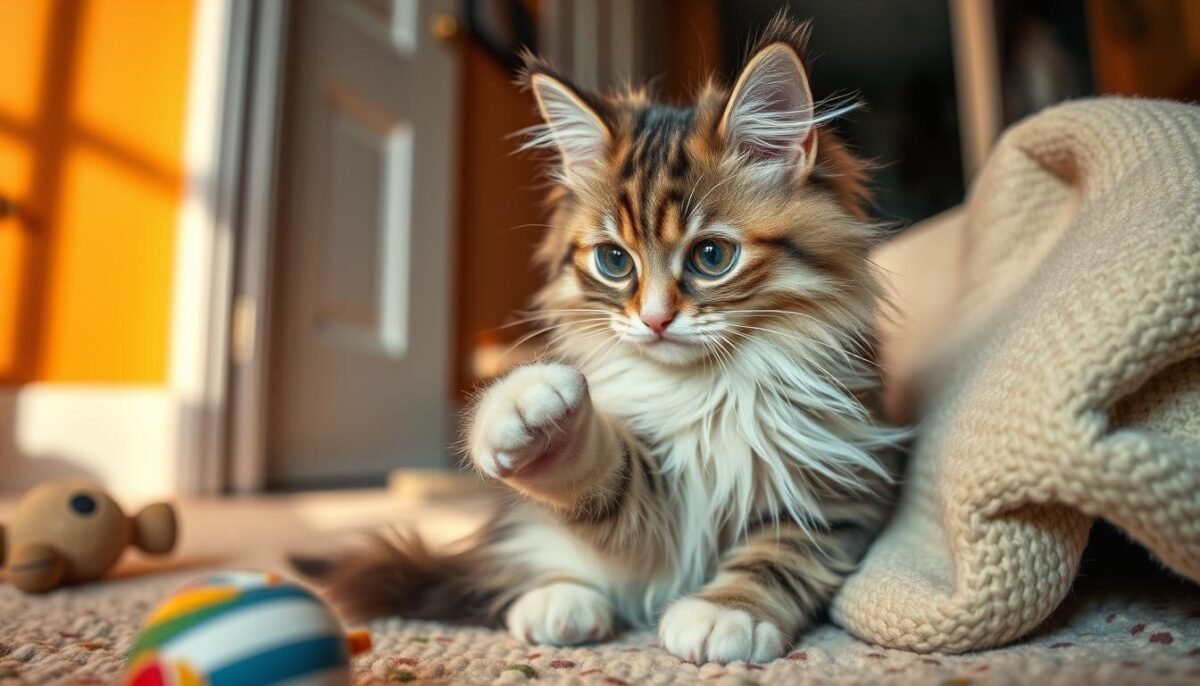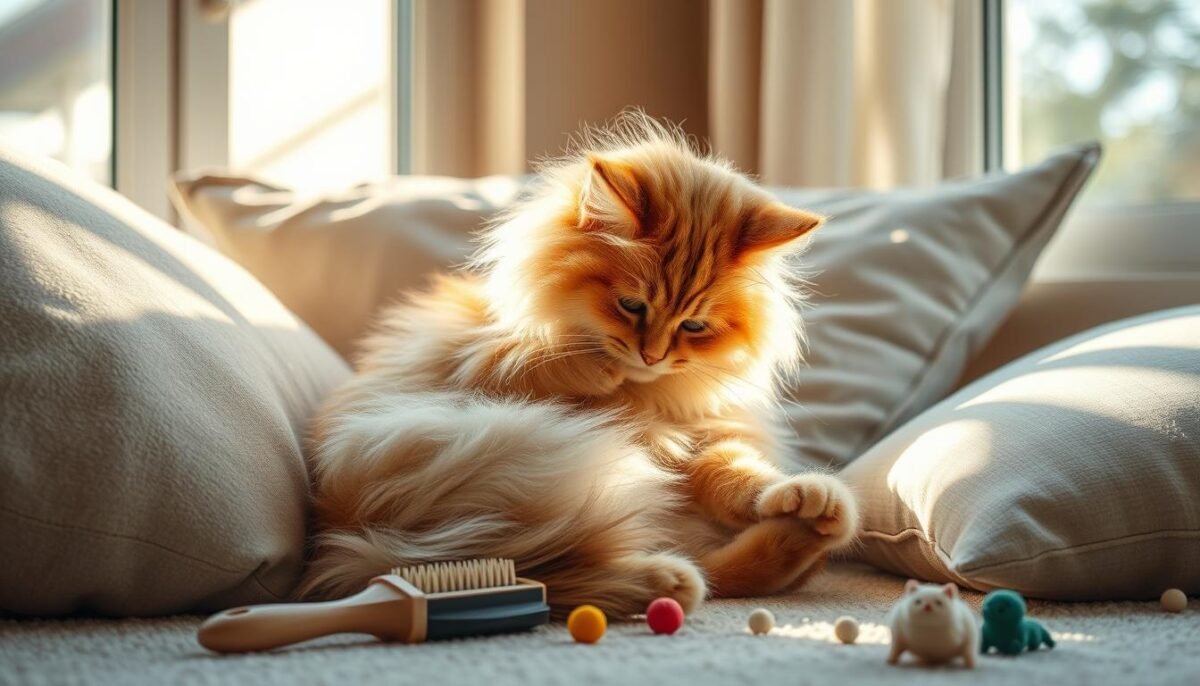Cats are known for their meticulous grooming. Elon Musk once said, “Cats are the best. They’re like furry little Zen masters, effortlessly gliding through life with a sense of grace and poise that we mere humans can only aspire to.” But when grooming becomes too much, it might mean there’s a problem.
In this guide, we’ll look into why cats groom too much. We’ll also talk about the signs and how to solve the issue. Understanding this behavior helps us support our pets’ health and happiness.
Key Takeaways
- Excessive grooming in cats can be a sign of underlying issues, such as stress, anxiety, or medical conditions.
- Understanding the reasons behind overgrooming is crucial for providing the appropriate care and support for our cats.
- Identifying the physical and behavioral symptoms of excessive grooming is the first step in addressing the problem.
- Implementing behavior modification techniques and seeking veterinary guidance can help manage excessive grooming effectively.
- Creating a calm, enriched environment for our cats can go a long way in promoting healthy grooming habits.
Understanding Cat Grooming Behavior
Grooming is a key part of a cat’s life. It’s not just for looks; it’s vital for their health. Cats use their tongues and teeth to clean their fur, removing dirt and parasites.
The Natural Importance of Grooming
Grooming is more than self-care for cats. It helps them stay clean and keeps their scent right. This is important for their social life and health.
Grooming as a Stress Relief Mechanism
Grooming can also help cats deal with stress. It calms them down and makes them feel in control. But, too much grooming can be a sign of psychogenic alopecia in cats.
Knowing when grooming is normal and when it’s not is crucial. Recognizing cat hair loss and obsessive grooming behavior in cats helps us support them better.
“Cats groom themselves not just for cleanliness, but also as a way to relieve stress and anxiety. Understanding this natural behavior can help us identify when it becomes excessive.”
Signs of Excessive Grooming in Cats
As pet owners, it’s key to spot signs of too much grooming in our cats. Knowing the difference between normal grooming and too much can help us fix problems early. Let’s look at the signs that show our cats might be over-grooming due to excessive cat scratching, anxiety, or skin issues.
Identifying Over-Grooming Habits
One big sign is when our cats spend more time licking, biting, or chewing their fur. If they’re doing this a lot, it might mean they’re over-grooming. Also, if they’re grooming all day, it’s a sign something’s wrong.
Physical Symptoms to Watch For
- Bald patches or thinning fur in specific areas
- Reddened, irritated skin from excessive licking or chewing
- Matted or unkempt appearance due to neglect of normal grooming
- Skin lesions, scabs, or wounds resulting from over-grooming
These signs show there might be a problem, like a health issue, anxiety, or a behavior problem. By watching for these signs, we can help our cats stay healthy and well-groomed.

“Excessive grooming can be a sign of a deeper issue, and it’s important to address it promptly to ensure the health and well-being of our cats.”
Common Causes of Excessive Grooming
When our feline friends groom too much, it might mean there’s something wrong. Let’s look at why they do this, from their minds to their bodies.
Anxiety and Stress Factors
Stress is a big reason for stress-induced grooming in cats. Changes like a new family member or pet can stress them out. They might start cat compulsive licking to calm down.
Skin Conditions and Allergies
Skin problems and allergies can make cats groom too much. They lick themselves to ease itchy skin, which can hurt more. Issues like feline acne and allergies can cause this.
Medical Issues to Consider
Medical problems can also lead to too much grooming. Issues like thyroid disorders and arthritis can make cats groom more. It’s key to check with a vet to find out why.
| Cause | Symptoms | Potential Solutions |
|---|---|---|
| Anxiety and Stress | Excessive licking, fur loss, skin irritation | Behavior modification, environmental enrichment, calming supplements |
| Skin Conditions and Allergies | Itching, redness, hair loss | Veterinary treatment, hypoallergenic diet, topical medications |
| Medical Issues | Fur loss, skin lesions, change in grooming habits | Veterinary examination, targeted treatment for underlying condition |

Knowing why cats groom too much helps us help them. We can keep their grooming healthy and balanced.
The Impact of Grooming on Our Cats
Excessive grooming in cats, also known as psychogenic alopecia, can harm their health and happiness. This behavior changes how they look and can risk their long-term health.
How Over-Grooming Affects Their Health
Excessive grooming can cause cats to lose their fur, leading to cat hair loss or alopecia. This can lead to skin irritation, inflammation, and skin infections. In bad cases, it can cause bald spots, making the problem worse.
Behavioral Changes Linked to Grooming
- Increased stress and anxiety levels, which can contribute to the obsessive grooming behavior in cats.
- Changes in social interactions, as cats that are preoccupied with excessive grooming may become less engaged with their surroundings and companions.
- Disruption in normal sleep patterns, as the constant need to groom can interfere with a cat’s natural rest cycle.
Understanding how excessive grooming affects our cats helps us take action. Recognizing signs and addressing causes ensures we care for our cats the best way.
Recognizing the Triggers of Grooming
As cat owners, it’s key to know what makes our cats groom too much. Finding out why they groom due to stress helps us care for them better.
Environmental Stressors
The place our cats live in affects their grooming. Changes like new family members, loud noises, or rearranged furniture can stress them out. This stress makes them groom more.
Changes in Routine or Lifestyle
When our cats’ routines change, they might groom too much. This includes new work schedules, moving homes, or getting new family members. These changes upset their routine and cause stress, leading to over-grooming.
Being aware of these factors helps us make our cats’ lives better. We can create a calmer, more enjoyable space for them. This reduces stress and grooming issues.

Solutions for Excessive Grooming
If your cat is grooming too much, there are ways to help. Excessive grooming, feline overgrooming, and cat compulsive licking can be signs of stress or health issues. A vet and some behavior changes can help your cat groom normally again.
Behavior Modification Techniques
Start by changing your cat’s behavior at home. This can help if they groom too much. Try these:
- Play with your cat a lot to keep them active
- Give them puzzle toys and scratching posts to keep them busy
- Make a routine to help them feel calm
- Use pheromone sprays to make them feel relaxed
Veterinary Consultation and Treatment Options
If your cat’s grooming doesn’t stop, see a vet. They can find out why and suggest treatments. Here are some options:
- Medicine for anxiety or pain
- Changing their food to fix allergies or nutrition
- Special creams or supplements for their skin and fur
- Behavior therapy to help with stress
Working with your vet, you can find the right way to help your cat. This will make them feel better and groom normally again.
Every cat is different, so what works for one might not work for another. Be patient and try different things until you find what works for your cat.
Creating a Calm Environment for Our Cats
It’s important to make our cats’ homes calm and stress-free. This is especially true for cats that groom too much, often due to cat anxiety grooming or other issues. By changing their space and adding fun activities, we can help them groom less and feel better.
Adjusting Their Space
First, check your cat’s living area and make changes to cut down on excessive cat scratching. Make sure they have places to scratch, like posts or pads. This natural act can help them relax. Also, add calming scents, like pheromone diffusers, to make the space more peaceful.
Enrichment Activities to Reduce Stress
Playing with your cat can help them focus less on grooming. Try interactive toys, puzzle feeders, and climbing spots. These activities encourage natural behaviors and keep them busy. Also, spending time with your cat can help them feel less bored and anxious.
| Enrichment Activity | Benefit |
|---|---|
| Interactive Toys | Engage your cat’s natural hunting instincts and provide mental stimulation. |
| Puzzle Feeders | Challenge your cat’s problem-solving skills and slow down their eating pace. |
| Vertical Platforms | Satisfy your cat’s desire to climb and survey their territory, reducing stress. |
By making their environment comfortable, fun, and stress-free, we can help our cats groom less. This reduces excessive cat scratching and other compulsive behaviors.
When to Seek Professional Help
Dealing with cats that groom too much can be tough. Simple changes in their life might help some. But, sometimes, you need a vet or animal behaviorist. Knowing when to ask for help is key to solving psychogenic alopecia in cats, feline psychogenic dermatitis, and obsessive grooming behavior in cats.
Signs It’s Time for a Vet Visit
If your cat’s grooming causes skin problems, bald spots, or other signs, see a vet. These could mean an allergy, skin infection, or something serious. A vet can find and treat the problem.
Understanding the Role of Animal Behaviorists
- For grooming issues linked to stress, anxiety, or changes, an animal behaviorist is a great choice.
- They can find the cause and create a plan to fix it. This might include changing the cat’s environment or using special techniques.
- They might also suggest medication to help with emotional or psychological issues behind the obsessive grooming behavior in cats.
Getting professional help is crucial for your cat’s grooming issues. It ensures they get the right care and support for their health and happiness.
Tips for Maintaining Healthy Grooming Habits
Keeping our cats groomed is key. Brushing and combing regularly can cut down on hair loss. It also lowers the chance of hairballs and keeps their coat shiny.
Looking after our cats’ skin is also important. It helps stop them from grooming too much. This can prevent skin problems.
Regular Grooming Routines We Can Follow
Having a set grooming schedule is vital. Brush or comb your cat a few times a week. This removes loose hair and keeps their coat in top shape.
It also cuts down on hairballs and skin issues. Don’t forget to trim their nails. This stops discomfort and scratching problems.
Choosing the Right Products for Skin Health
Choosing the right grooming products is crucial. Look for gentle, cat-safe shampoos and conditioners. Also, pick brushes made for healthy skin and coat.
Stay away from harsh chemicals and fragrances. They can irritate the skin. This might lead to too much grooming or hair loss. Paying attention to your cat’s needs helps keep grooming healthy.
FAQ
What are the signs of excessive grooming in cats?
Signs of too much grooming in cats include a lot of licking, chewing, or scratching. You might also see bald spots or thinning fur. Look for skin irritation or redness and changes in their behavior like being more agitated or anxious.
What are the most common causes of excessive grooming in cats?
Cats groom too much because of stress and anxiety, skin problems, or allergies. They might also groom more if they’re in pain or have a health issue.
How does excessive grooming affect a cat’s health?
Too much grooming can cause skin irritation, hair loss, and infections. It can also make a cat very stressed and upset. This can mess up their normal behavior and daily routines.
What can we do to help reduce excessive grooming in our cats?
To cut down on grooming, try changing their behavior. Make their environment calm and fun. Also, check for any health problems and get help from a vet or animal behaviorist if needed.
When should we seek professional help for our cat’s excessive grooming?
Get a vet’s help if your cat’s grooming is causing hair loss or skin problems. Also, seek help if it doesn’t get better with simple steps at home.
How can we maintain healthy grooming habits for our cats?
Keep grooming healthy by grooming regularly and using the right tools and products. Give your cat fun activities and enrichment to lower stress and anxiety.






